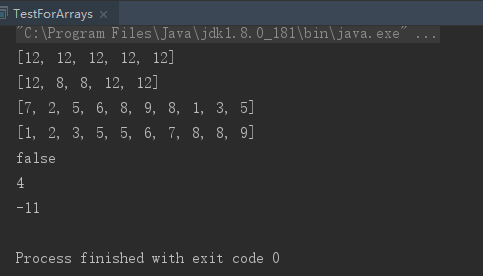Java工具包中的Arrays工具类里面有数组的快速排序算法。
源码如下:
1 /** 2 * Sorts the specified range of the array using the given 3 * workspace array slice if possible for merging 4 * 5 * @param a the array to be sorted 6 * @param left the index of the first element, inclusive, to be sorted 7 * @param right the index of the last element, inclusive, to be sorted 8 * @param work a workspace array (slice) 9 * @param workBase origin of usable space in work array 10 * @param workLen usable size of work array 11 */ 12 static void sort(int[] a, int left, int right, 13 int[] work, int workBase, int workLen) { 14 // Use Quicksort on small arrays 15 if (right - left < QUICKSORT_THRESHOLD) { 16 sort(a, left, right, true); 17 return; 18 } 19 20 /* 21 * Index run[i] is the start of i-th run 22 * (ascending or descending sequence). 23 */ 24 int[] run = new int[MAX_RUN_COUNT + 1]; 25 int count = 0; run[0] = left; 26 27 // Check if the array is nearly sorted 28 for (int k = left; k < right; run[count] = k) { 29 if (a[k] < a[k + 1]) { // ascending 30 while (++k <= right && a[k - 1] <= a[k]); 31 } else if (a[k] > a[k + 1]) { // descending 32 while (++k <= right && a[k - 1] >= a[k]); 33 for (int lo = run[count] - 1, hi = k; ++lo < --hi; ) { 34 int t = a[lo]; a[lo] = a[hi]; a[hi] = t; 35 } 36 } else { // equal 37 for (int m = MAX_RUN_LENGTH; ++k <= right && a[k - 1] == a[k]; ) { 38 if (--m == 0) { 39 sort(a, left, right, true); 40 return; 41 } 42 } 43 } 44 45 /* 46 * The array is not highly structured, 47 * use Quicksort instead of merge sort. 48 */ 49 if (++count == MAX_RUN_COUNT) { 50 sort(a, left, right, true); 51 return; 52 } 53 } 54 55 // Check special cases 56 // Implementation note: variable "right" is increased by 1. 57 if (run[count] == right++) { // The last run contains one element 58 run[++count] = right; 59 } else if (count == 1) { // The array is already sorted 60 return; 61 } 62 63 // Determine alternation base for merge 64 byte odd = 0; 65 for (int n = 1; (n <<= 1) < count; odd ^= 1); 66 67 // Use or create temporary array b for merging 68 int[] b; // temp array; alternates with a 69 int ao, bo; // array offsets from 'left' 70 int blen = right - left; // space needed for b 71 if (work == null || workLen < blen || workBase + blen > work.length) { 72 work = new int[blen]; 73 workBase = 0; 74 } 75 if (odd == 0) { 76 System.arraycopy(a, left, work, workBase, blen); 77 b = a; 78 bo = 0; 79 a = work; 80 ao = workBase - left; 81 } else { 82 b = work; 83 ao = 0; 84 bo = workBase - left; 85 } 86 87 // Merging 88 for (int last; count > 1; count = last) { 89 for (int k = (last = 0) + 2; k <= count; k += 2) { 90 int hi = run[k], mi = run[k - 1]; 91 for (int i = run[k - 2], p = i, q = mi; i < hi; ++i) { 92 if (q >= hi || p < mi && a[p + ao] <= a[q + ao]) { 93 b[i + bo] = a[p++ + ao]; 94 } else { 95 b[i + bo] = a[q++ + ao]; 96 } 97 } 98 run[++last] = hi; 99 } 100 if ((count & 1) != 0) { 101 for (int i = right, lo = run[count - 1]; --i >= lo; 102 b[i + bo] = a[i + ao] 103 ); 104 run[++last] = right; 105 } 106 int[] t = a; a = b; b = t; 107 int o = ao; ao = bo; bo = o; 108 } 109 }
java.util.Arrays类能方便的操作数组,它所有的方法都是静态的。
1.filll方法 :给数组中的某段元素附上相同值。
2.sort方法:对数组中某段元素排序。
3.equals方法:比较两个数组,判断的是数组中元素值是否相等。
4.binarySearch方法:对排过序的数组进行二分法查找。
测试用例:
1 package recursion; 2 3 import java.util.Arrays; 4 5 /** 6 * @author zsh 7 * @company wlgzs 8 * @create 2019-02-17 9:33 9 * @Describe Arrays方法测试 10 */ 11 public class TestForArrays { 12 13 public static void main(String[] args) { 14 //填充数组,将arr[]中所有元素的值初始为0 15 int[] arr = new int[5]; 16 Arrays.fill(arr,12); 17 System.out.println(Arrays.toString(arr)); 18 //将arr中的第2个到第三个元素的值赋为8 19 Arrays.fill(arr,1,3,8); 20 System.out.println(Arrays.toString(arr)); 21 //对数组进行排序 22 int[] arr1 = new int[]{7,6,8,5,2,9,8,1,3,5}; 23 //对数组的第二个到第6个元素进行排序 24 Arrays.sort(arr1,1,6); 25 System.out.println(Arrays.toString(arr1)); 26 //对整个数组进行排序 27 Arrays.sort(arr1); 28 System.out.println(Arrays.toString(arr1)); 29 //比较数组元素是否相等 30 System.out.println(Arrays.equals(arr,arr1)); 31 //使用二分法在数组中查找指定元素所在的下标 32 //数组必须是先排好序的 33 System.out.println(Arrays.binarySearch(arr1,5)); 34 //如果不存在,就返回负数 35 System.out.println(Arrays.binarySearch(arr1,20)); 36 } 37 38 39 }
控制台输出:






















 1188
1188











 被折叠的 条评论
为什么被折叠?
被折叠的 条评论
为什么被折叠?








